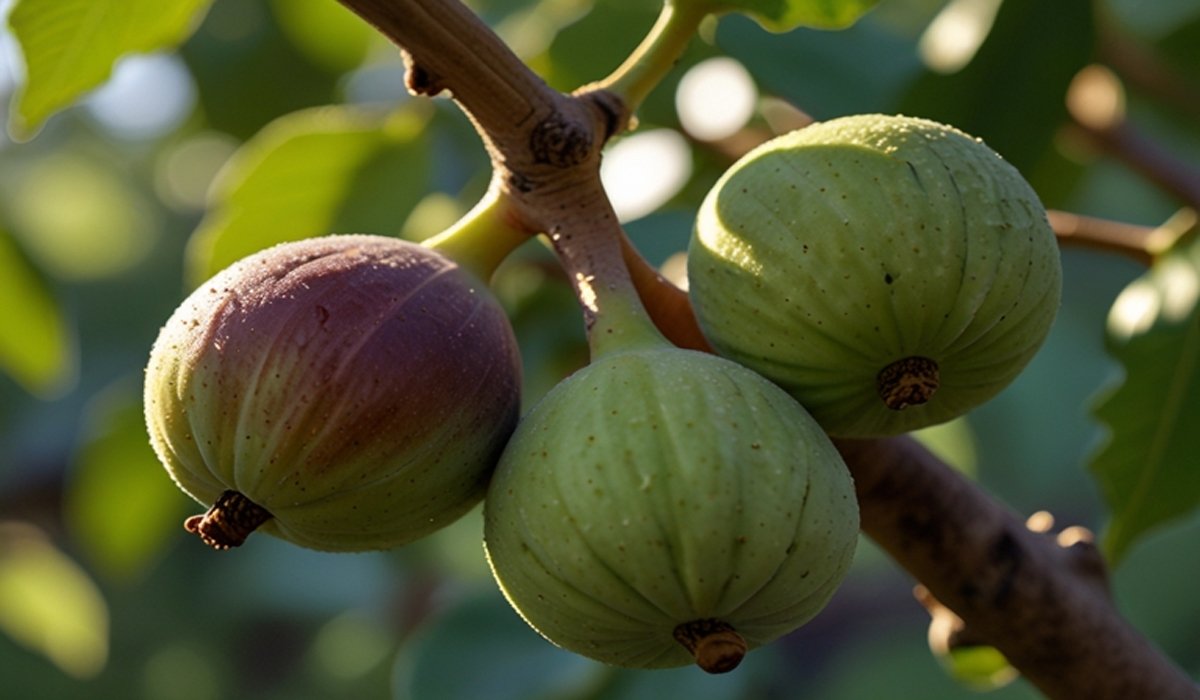Ever tasted a fig that whispers of ancient orchards and desert blooms? Imagine biting into a velvety treasure, its pale skin giving way to an amber-red interior bursting with a sweetness reminiscent of floral honey and sun-ripened fruit. That’s the magic of the Byadi fig – a hidden gem of the Levant, prized for centuries and now capturing the hearts of fig lovers and home growers worldwide.
Beyond its delicate beauty lies a story of resilience and exquisite flavor, making the Byadi more than just a fruit; it’s a taste of cultural heritage. Let’s peel back the layers of this remarkable honey-fig.
The Allure of the Byadi: A Honey-Fig Like No Other
Hailing from the sun-drenched landscapes of Lebanon, Syria, and Jordan, the Byadi fig (pronounced roughly “bee-AH-dee”) lives up to its name. Derived from the Arabic “abyad” meaning “white,” it boasts a distinctive light-colored skin that sets it apart from many darker, more common fig varieties. But its true magic lies within.
- Flavor Symphony: The Byadi delivers an unforgettable taste experience. Think rich, complex sweetness – not just sugary, but layered with distinct floral notes and a deep, warm honeyed character. It’s often described as the quintessential “honey fig.”
- Visual & Textural Delight: Inside its light skin, you’ll find pulp ranging from vibrant amber to deep, enticing red. The texture is wonderfully delicate – tender, juicy, and meltingly soft when perfectly ripe.
- Cultural Keystone: This isn’t just another fruit tree. The Byadi is deeply woven into the agricultural traditions of the Middle East, representing generations of careful cultivation and a love for exceptional quality figs. Growing a Byadi connects you to this rich history.
Cultivating Your Own Byadi Fig Tree: A Rewarding Journey
Good news for gardeners! The Byadi isn’t just a collector’s dream; it’s known for being a relatively dependable and rewarding tree for home growers. Here’s what you need to know:
- Growth Habit: Exhibits moderate vigor, making it manageable in gardens or large containers. It won’t overwhelm your space like some ultra-vigorous varieties.
- Fruit Production: Primarily known as a single-crop fig, reliably producing its main harvest in late summer. The fruits are typically medium to large in size.
- The “Hang” Factor: A prized characteristic! Byadi figs have a strong peduncle (stem attachment), meaning they cling firmly to the tree until they achieve perfect ripeness. This reduces premature dropping and lets the fruit develop its full, legendary flavor and honeyed sweetness on the branch. No more chasing half-ripe figs across the ground!
- Early Ripening: Compared to many other high-quality figs, Byadi tends to ripen its main crop relatively early in the fig season, offering that delectable honey flavor sooner.
Table: Byadi Fig – Quick Grower’s Guide
| Characteristic | Details |
| Skin Color | Light (“White”) |
| Pulp Color | Amber to Deep Red |
| Flavor Profile | Intensely Sweet, Pronounced Floral Honey Notes, Complex |
| Texture | Delicate, Juicy, Melting |
| Vigor | Moderate |
| Crop Type | Single Crop (Late Summer) |
| Fruit Size | Medium to Large |
| Ripening Hold | Excellent – Fruits hang firmly until fully ripe |
| Ripening Time | Early to Mid-Season for main crop |
| Best Suited For | Collectors, Home Gardeners, Warm Climates (Zones 7-10), Container Growth |
Read also: NoodleMagazine: Where Culinary Passion Meets Global Noodle Culture
Why Choose a Byadi Fig Tree?
- Unmatched Flavor: Simply put, it’s one of the best-tasting honey figs available. If you crave that intense, floral sweetness, Byadi delivers.
- Reliability: Known for being a consistent bearer once established, offering a dependable late-summer harvest.
- Manageable Size: Its moderate growth makes it suitable for smaller spaces and easier pruning.
- Cultural Connection: Grow a piece of living Middle Eastern agricultural history.
- Grower Friendly: The strong hang of the fruit until ripe reduces losses and simplifies harvest timing. It’s less fussy about dropping fruit prematurely than some varieties.
Finding Your Byadi Tree & Getting Started
While you won’t find Byadi figs at your average supermarket (they are too delicate for long shipping), the trees are increasingly available to passionate growers:
- Specialty Nurseries: Look for reputable online nurseries specializing in rare and unique figs. Sources like Off The Beaten Path Nursery (offthebeatenpathnursery.com) and Figbid (figbid.com) are often excellent starting points for finding authentic Byadi cuttings or young trees. Always check reviews and the seller’s reputation.
- Fig Enthusiast Communities: Online forums and local fig grower associations can be invaluable resources for sourcing trees or cuttings and getting specific growing tips.
Planting & Care Tips:
- Sun Worship: Plant your Byadi in the sunniest spot possible – at least 8 hours of direct sun daily is ideal for maximum sweetness.
- Well-Drained Soil is Key: Figs despise “wet feet.” Ensure excellent drainage. Sandy loam is perfect. Amend heavy clay soils significantly or consider raised beds or containers.
- Water Wisely: Water deeply and regularly, especially during fruit development and hot weather, but allow the soil to dry slightly between waterings. Reduce water in late fall/winter.
- Feeding: Figs aren’t heavy feeders. A balanced fertilizer in early spring and maybe a light feeding in early summer is usually sufficient. Avoid excessive nitrogen.
- Winter Protection: While moderately hardy, Byadi benefits from protection in colder zones (below Zone 7). Mulch heavily around the base, and consider wrapping or burying the tree in colder regions. Container growth allows you to move the tree to a sheltered spot (garage, shed) during freezing temperatures.
The Joy of the Harvest: Savoring Byadi
Patience is rewarded! Harvest your Byadi figs when they are fully soft to the touch, slightly drooping at the neck, and may show a tiny drop of honey-like nectar at the eye (bloom end). The skin might develop slight cracks – a sign of peak sweetness! The flavor is best enjoyed fresh, straight from the tree, within a day or two of picking. Experience that burst of honeyed sunshine!
Bringing Home the Honey: Your Byadi Adventure Awaits
The Byadi fig is more than just a fruit; it’s an invitation to cultivate a piece of the Middle East’s rich horticultural legacy and experience one of nature’s most exquisite sweet treats. Its unique light skin guards an interior glowing with amber and red, promising a flavor journey of intense floral honey and delicate texture. With moderate growth, dependable late-summer harvests, and the delightful trait of holding its fruit until perfectly ripe, the Byadi is a compelling choice for both seasoned fig collectors and home gardeners seeking something truly special.
Ready to Taste the Legend?
- Source Your Tree: Explore trusted nurseries like Off The Beaten Path or Figbid.
- Find Your Sunny Spot: Prep that perfect, well-drained planting location.
- Join the Community: Connect with other fig enthusiasts online or locally.
- Plant, Nurture, and Wait: The anticipation is part of the joy!
Imagine: In a few seasons, you could be plucking your own sun-warmed Byadi figs, tasting the honeyed sunshine and centuries of tradition. Isn’t it time you added this white gem to your garden?
Share your fig-growing experiences or questions about the Byadi below! Have you tasted this honeyed treasure?
Meta Description: Discover the Byadi fig! Prized Middle-Eastern honey-fig with light skin, amber-red pulp & intense floral sweetness. Learn why growers love this unique, dependable variety.
Image Caption: Sun-drenched Byadi figs ripening on the branch, their pale skins glowing against green leaves – a taste of Middle Eastern sunshine.
Frequently Asked Questions (FAQs) About Byadi Figs
- What does a Byadi fig taste like?
The Byadi is renowned for its exceptionally sweet, complex flavor profile dominated by rich floral honey notes. It’s often considered one of the best-tasting “honey fig” varieties, with a delicate, melting texture and amber to red pulp. - Why is it called a “white” fig? Is the pulp white?
The name “Byadi” comes from the Arabic word “abyad,” meaning “white,” referring to its distinctive light-colored skin, not the pulp. The pulp inside is typically a beautiful amber or deep red color. - Do Byadi fig trees produce two crops (breba and main)?
The Byadi is primarily known as a single-crop fig. It reliably produces its main (and often only) crop in late summer. Breba crops (an early crop on old wood) are generally not a significant feature of this variety. - Are Byadi figs good for home gardeners?
Absolutely! Byadi trees are known for being moderately vigorous (easier to manage), relatively dependable bearers in suitable climates, and produce high-quality fruit that hangs well until ripe. Their exceptional flavor makes them a top choice for enthusiasts and home growers seeking something special. - Where can I buy a Byadi fig tree?
Due to its specialty nature, you won’t typically find Byadi at large chain garden centers. Your best bets are reputable online nurseries specializing in rare and unique figs (like Off The Beaten Path Nursery) or online auction/marketplaces dedicated to figs (like Figbid). Always research the seller’s reputation. - What growing zones are suitable for Byadi figs?
Byadi figs thrive best in warm climates similar to USDA Zones 7-10. They need a long, hot growing season to ripen their fruit properly. In Zone 6 and colder, significant winter protection (heavy mulching, wrapping, or container growing with winter shelter) is essential, and ripening the main crop can be more challenging. - How do I know when a Byadi fig is ripe?
Look for these signs: the fruit feels very soft to the touch, the neck may soften and droop, the skin color deepens slightly, you might see a tiny drop of syrup (honey) at the eye (bottom), and sometimes the skin develops small cracks. Ripe Byadi figs are delicate, so handle gently!
You may also like: Çeciir: The Ancient Chickpea Tradition Bridging Culture, Cuisine, and Strategy











